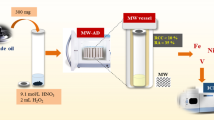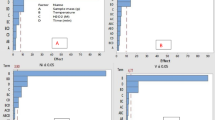Abstract
A microwave procedure for the digestion of the NIST 1634b reference material “residual fuel oil” in closed pressurized vessels was developed in an attempt to facilitate routine analysis and obtain reproducible conditions or comparable results. The influence of sample size, reagent composition and volume, microwave power, and duration of heating on the digestion procedure was studied. Pressure and temperature inside the reaction vessels were monitored to determine the progression of the reaction and to develop optimal conditions. A nine-step heating program requiring 36.5 min with microwave power not exceeding 450 W in the pulsed mode was found suitable for the digestion of ∼ 250 mg fuel oil with a mixture of nitric acid (5.0 mL) and hydrogen peroxide (2.0 mL). The reproducibility of microwave power was determined in terms of the relative standard deviations (n = 3) for temperature (2.7%) and pressure (4.9%) data. The vapor pressures obtained with 5.0 mL Milli-Q water (heated) in an 80-mL digestion vessel showed good agreement with literature data. The excess acid in the resulting digests was removed by evaporation and the concentrations of 24 elements (Ag, Al, As, Ba, Bi, Ca, Cd, Co, Cr, Cu, Fe, Hg, Mg, Mo, Ni, Pb, Sb, Sn, Sr, Ti, Tl, V, U, and Zn) were determined in the diluted digests by inductively coupled plasma mass spectrometry (ICP-MS). The experimental results were in good agreement with the certified and recommended concentrations for eight elements (Al, As, Co, Cr, Ni, Pb, V, Zn) in solutions obtained after one digestion step. An additional digestion step, consisting of intermediate cooling and venting stages, was required for the accurate determination of Fe. No agreement was reached for Ca and Ba even after two-step digestion. The proposed method of digestion provided precise results with relative standard deviations generally less than 5% for most of the elements determined.
Similar content being viewed by others
Author information
Authors and Affiliations
Additional information
Received: 4 October 1999 / Revised: 1 December 1999 / Accepted: 7 December 1999
Rights and permissions
About this article
Cite this article
Wondimu, T., Goessler, W. & Irgolic, K. Microwave digestion of “residual fuel oil” (NIST SRM 1634b) for the determination of trace elements by inductively coupled plasma-mass spectrometry. Fresenius J Anal Chem 367, 35–42 (2000). https://doi.org/10.1007/s002160051595
Issue Date:
DOI: https://doi.org/10.1007/s002160051595




